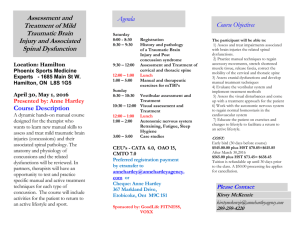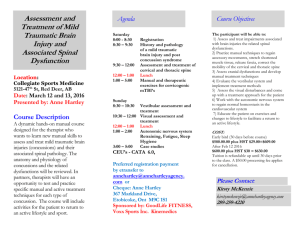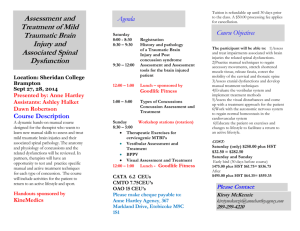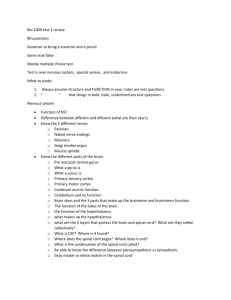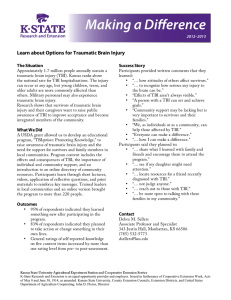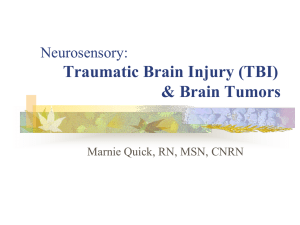37000 Number of Americans living with a
advertisement
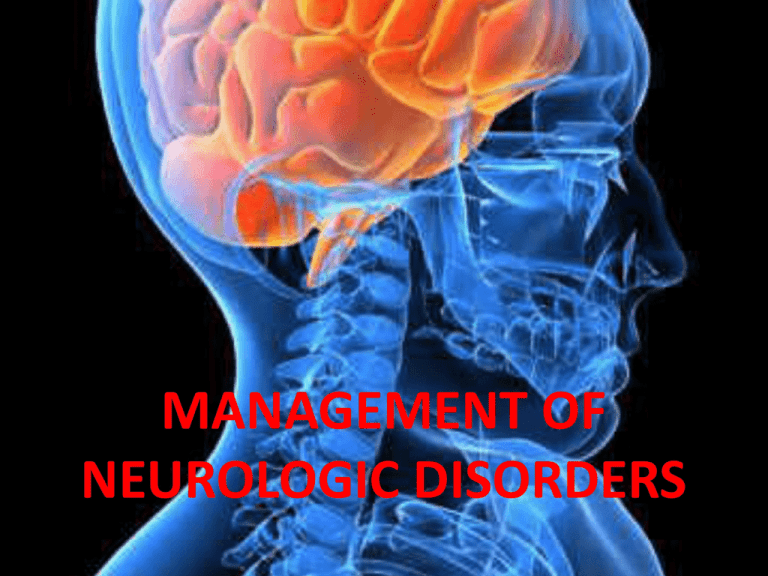
MANAGEMENT OF NEUROLOGIC DISORDERS What is Traumatic Brain Injury? Closed – head collides with another object but there is no opening through the skull and dura Open – object penetrates the skull, enters the brain and damages the soft brain tissue in its path. Exposes the brain STATISTICS Annual number of people who experience a traumatic brain injury: • 1. 4 million annually in the United States Deaths: 50,000 Hospitalization: 235,000 Among children ages 0 to 14 years Deaths: 26, 850 Hospitalizations: 37,000 Number of Americans living with a traumatic brain injury: Approximately 5.3 million LEADING CAUSES OF TBI : CLASSIFICATION OF TBI: MILD • loss of consciousness and/or confusion and disorientation is shorter than 30 minutes • The person looks normal and often moves normal in spite of not feeling or thinking normal. SEVERE • loss of consciousness for more than 30 minutes and memory loss after the injury or penetrating skull injury longer than 24 hours • Results in permanent neurobiological damage that can produce lifelong deficits to varying degrees. CONCUSSION vs CONTUSION CONCUSSION • Temporary loss of neurologic function with no apparent structural damage lasting for a few seconds to few minutes • Jarring of the brain that caused it to stop functioning momentarily CONTUSION • More severe injury in which the brain is bruised, with possible surface hemorrhage • Unconscious for more than a few seconds or minutes • Picture is somewhat similar to that of shock MANAGEMENT of TBI MAINTAINING THE AIRWAY • Keep unconscious patient in a position that facilitates drainage of oral secretion • Establish effective suctioning procedures • Guard against aspiration and respiratory insufficiency • Monitor for pulmonary complications MAINTAIN HYDRATION & ADEQUATE NUTRITION • Fluid is administered through the IV for nutrition and liquid. • A urinary catheter is put in the bladder for urine collection. • It is important to maintain the unconscious patient's blood pressure through IV fluid and medication. MAINTAINING SKIN INTEGRITY • The patient is turned and positioned in bed • A compression device wrapped around the legs that prevents blood clots. Daily injections are also given to prevent blood clots. SEIZURE PRECAUTION • Dilantin is the usual medication administered through the IV to prevent seizures. A tetanus shot also may be given. RECOVERY • Duration of Coma. The shorter the coma, the better the prognosis. • Post-traumatic amnesia. The shorter the amnesia, the better the prognosis. • Age. Patients over 60 or under age 2 have the worst prognosis, even if they suffer the same injury as someone not in those age groups. What is it? Spinal cord injuries cause myelopathy or damage to white matter or myelinated fiber tracts that carry signals to and from the brain. It also damages gray matter in the central part of the spine, causing segmental losses of interneurons and motorneurons. S P I N A L C O R D CAUSES OF SCI STAGES • Stage of spinal shock • sensation and motor power localized below the vertical height of the lesion are lost. This stage lasts for 2 to 3 weeks in humans, and hours to days in other animals due to a lesser degree of encephalitis. • Stage of recovery • after a period typically ranging from 2 to 3 weeks of injury, the nerves partially recover, and the return of segmental reflexes produce paraplegia-in-flexion. C. Stage of reflex failure • after a period of days the recovered reflexes again start to give way due to complete degeneration of nerve cells. SYMPTOMS The location of the The severity of the injury. injury • In general, injuries • Spinal cord injuries are classified as that are higher in partial or complete, your spinal cord depending on how produce more much of the cord paralysis. width is damaged. COMPLICATIONS Thrombophlebitis • Measures such as ROM exercises, thigh-high elastic compression stockings, adequate hydration and anticoagulation medications (heparin and warfarin ) as prescribed are given Orthostatic Hypotension • Activity should be planned in advance and adequate time given for a slow progression of position changes Autonomic Dysreflexia • Stimuli that may trigger this: distended bladder ( most common ); distention or contraction of visceral organs, especially the bowel; or stimulation to the skin NURSING BEDS • Clinitron Bed • Tilt Bed STRYKER FRAME ROTAREST BED


